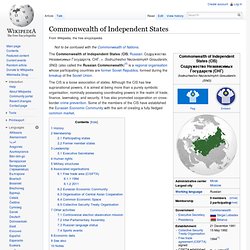

1991: Gorbachev resigns as Soviet Union breaks up. 1991: Gorbachev resigns as Soviet Union breaks up Mikhail Gorbachev, leader of the Soviet Union for almost seven years and executive president for nearly two, has stepped down from office.

He announced his resignation in a 10 minute speech, broadcast live on television, as the Soviet Union passed into history. It has been replaced by the Commonwealth of Independent States (CIS). The 60-year-old appeared solemn but composed. "Due to the situation which has evolved as a result of the formation of the Commonwealth of Independent states I hereby discontinue my activities at the post of president of the Union of Soviet Socialist Republics," he said. He said he was resigning on a matter of principle, adding the decision to dismantle the state should have been made "on the basis of popular will". Mr Gorbachev, highly regarded abroad but not at home, listed his achievements. "Free elections have become a reality. Tributes It was an image mirrored at Soviet embassies around the world. Moscow, December 25, 1991: Introduction. Please support our site by enabling javascript to view ads.

This is the first of three excerpts from Conor O'Clery's new book, "Moscow, December 25, 1991: The last day of the Soviet Union. " The second part explains how Mikhail Gorbachev destroyed his rival upstart, Boris Yeltsin. The third part explains how Yeltsin began the climb to leadership of Russia, from where he was able to bring down Gorbachev. During his six years and nine months as leader of the Soviet Union, Mikhail Gorbachev is accompanied everywhere by two plainclothes colonels with expressionless faces and trim haircuts. They are so unobtrusive that they often go unnoticed by the president’s visitors and even by his aides. The inscrutable colonels are the guardians of a chunky black Samsonite briefcase with a gold lock weighing 3.3 pounds that always has to be within reach of the president.
There are three nuclear suitcases in total. This all changes on December 25, 1991. Commonwealth of Independent States. The Commonwealth of Independent States (CIS; Russian: Содружество Независимых Государств, СНГ, tr.

Sodruzhestvo Nezavisimykh Gosudarstv, SNG) (also called the Russian Commonwealth)[6] is a regional organisation whose participating countries are former Soviet Republics, formed during the breakup of the Soviet Union. The CIS is a loose association of states. Although the CIS has few supranational powers, it is aimed at being more than a purely symbolic organisation, nominally possessing coordinating powers in the realm of trade, finance, lawmaking, and security. It has also promoted cooperation on cross-border crime prevention.
Dissolution of the Soviet Union. The Union of Soviet Socialist Republics (USSR) formally ceased to exist on 26 December 1991.

The increasing political unrest led the establishment of the Soviet military and the Communist Party of the Soviet Union to attempt a coup d'état to oust Mikhail Gorbachev and re-establish a strong central regime in August 1991.[2] On December 26, 1991, the dissolution of the Soviet Union was finalized by declaration no. 142-H of the Soviet of the Republics of the Supreme Soviet of the Soviet Union,[1] acknowledging the independence of the twelve republics of the Soviet Union, and creating the Commonwealth of Independent States (CIS). On the previous day, 25 December 1991, Soviet President Mikhail Gorbachev had resigned, declaring his office extinct, and handed over the Soviet nuclear missile launching codes to Russian President Boris Yeltsin.
That same evening at 7:32 P.M. the Soviet flag was lowered from the Kremlin for the last time and replaced with the Russian tricolor. Cold War Museum. Additional Links Back to the 1990s In December of 1991, as the world watched in amazement, the Soviet Union disintegrated into fifteen separate countries.

Its collapse was hailed by the west as a victory for freedom, a triumph of democracy over totalitarianism, and evidence of the superiority of capitalism over socialism. The United States rejoiced as its formidable enemy was brought to its knees, thereby ending the Cold War which had hovered over these two superpowers since the end of World War II. Indeed, the breakup of the Soviet Union transformed the entire world political situation, leading to a complete reformulation of political, economic and military alliances all over the globe.
What led to this monumental historical event? However, this project of creating a unified, centralized socialist state proved problematic for several reasons. Back to Top.